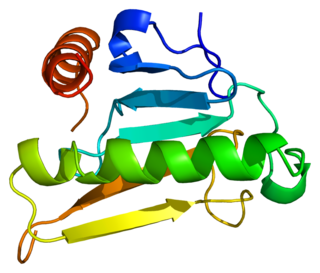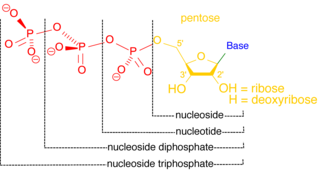
Adenosine triphosphate (ATP) is a nucleoside triphosphate that provides energy to drive and support many processes in living cells, such as muscle contraction, nerve impulse propagation, and chemical synthesis. Found in all known forms of life, it is often referred to as the "molecular unit of currency" for intracellular energy transfer.

Adenosine monophosphate (AMP), also known as 5'-adenylic acid, is a nucleotide. AMP consists of a phosphate group, the sugar ribose, and the nucleobase adenine. It is an ester of phosphoric acid and the nucleoside adenosine. As a substituent it takes the form of the prefix adenylyl-.

In chemistry, pyrophosphates are phosphorus oxyanions that contain two phosphorus atoms in a P−O−P linkage. A number of pyrophosphate salts exist, such as disodium pyrophosphate and tetrasodium pyrophosphate, among others. Often pyrophosphates are called diphosphates. The parent pyrophosphates are derived from partial or complete neutralization of pyrophosphoric acid. The pyrophosphate bond is also sometimes referred to as a phosphoanhydride bond, a naming convention which emphasizes the loss of water that occurs when two phosphates form a new P−O−P bond, and which mirrors the nomenclature for anhydrides of carboxylic acids. Pyrophosphates are found in ATP and other nucleotide triphosphates, which are important in biochemistry. The term pyrophosphate is also the name of esters formed by the condensation of a phosphorylated biological compound with inorganic phosphate, as for dimethylallyl pyrophosphate. This bond is also referred to as a high-energy phosphate bond.

Bis(5'-adenosyl)-triphosphatase also known as fragile histidine triad protein (FHIT) is an enzyme that in humans is encoded by the FHIT gene.
In enzymology, a bis(5'-nucleosyl)-tetraphosphatase (asymmetrical) (EC 3.6.1.17) is an enzyme that catalyzes the chemical reaction
In enzymology, a bis(5'-nucleosyl)-tetraphosphatase (symmetrical) (EC 3.6.1.41) is an enzyme that catalyzes the chemical reaction

In Enzymology, a dUTP diphosphatase (EC 3.6.1.23) is an enzyme that catalyzes the chemical reaction
In enzymology, a guanosine-5'-triphosphate,3'-diphosphate diphosphatase (EC 3.6.1.40) is an enzyme that catalyzes the chemical reaction

In enzymology, a nucleoside-triphosphatase(NTPase) (EC 3.6.1.15) is an enzyme that catalyzes the chemical reaction
In enzymology, a nucleoside-triphosphate diphosphatase (EC 3.6.1.19) is an enzyme that catalyzes the chemical reaction
Thiamine-triphosphatase is an enzyme involved in thiamine metabolism. It catalyzes the chemical reaction
In enzymology, a thymidine-triphosphatase (EC 3.6.1.39) is an enzyme that catalyzes the chemical reaction
The enzyme dGTPase (EC 3.1.5.1) catalyzes the reaction
In enzymology, an adenosine-phosphate deaminase (EC 3.5.4.17) is an enzyme that catalyzes the chemical reaction
In enzymology, an ATP adenylyltransferase (EC 2.7.7.53) is an enzyme that catalyzes the chemical reaction
In enzymology, a nucleoside-triphosphate-adenylate kinase is an enzyme that catalyzes the chemical reaction
In enzymology, a polyphosphate kinase, or polyphosphate polymerase, is an enzyme that catalyzes the formation of polyphosphate from ATP, with chain lengths of up to a thousand or more orthophosphate moieties.

Bis(5'-nucleosyl)-tetraphosphatase [asymmetrical] is an enzyme that in humans is encoded by the NUDT2 gene.
Diadenosine hexaphosphate hydrolase (AMP-forming) (EC 3.6.1.60, hAps1, NUDT11 (gene), hAps2, NUDT10 (gene)) is an enzyme with systematic name P1,P6-bis(5'-adenosyl)hexaphosphate nucleotidohydrolase (AMP-forming). This enzyme catalyses the following chemical reaction
Diadenosine hexaphosphate hydrolase (ATP-forming) (EC 3.6.1.61, Ndx1) is an enzyme with systematic name P1,P6-bis(5'-adenosyl)hexaphosphate nucleotidohydrolase (ATP-forming). This enzyme catalyses the following chemical reaction







